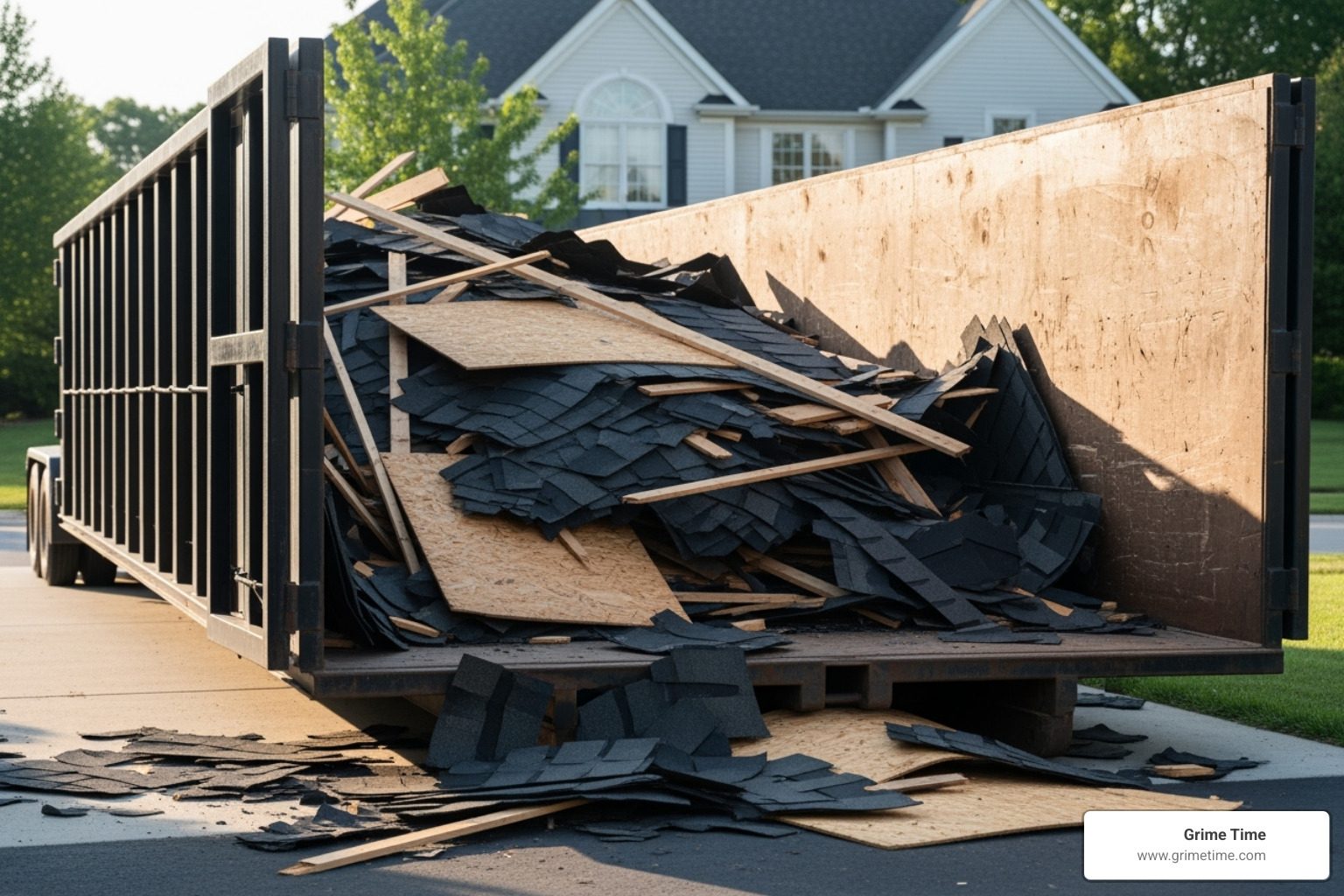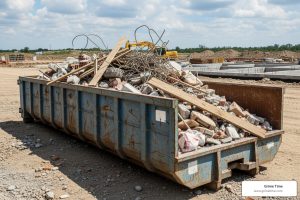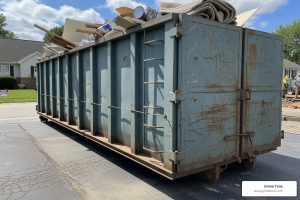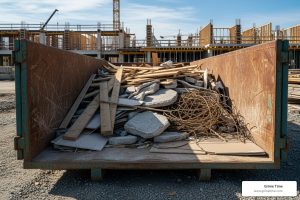Why Getting the Right Dumpster for Roofing Makes or Breaks Your Project
Dumpster for roofing projects isn’t just about waste removal – it’s about keeping your job site safe, your timeline on track, and your costs under control. With roofing debris being among the heaviest construction materials you’ll handle, choosing the wrong size can lead to expensive overage fees or project delays.
Quick Answer for Roofing Dumpster Rentals:
- Small roofs (under 2,000 sq ft): 10-yard dumpster
- Medium roofs (2,000-3,500 sq ft): 20-yard dumpster
- Large roofs (3,500+ sq ft): 30-yard dumpster or multiple containers
- Weight matters most: Asphalt shingles weigh 2-4 lbs per square foot
- Always account for: Multiple layers, underlayment, nails, and flashing
The challenge isn’t justpicking any dumpster. A typical residential roof tear-off generates 2,400 to 4,200 pounds of waste per 1,000 square feet, depending on your shingle type. Get the sizing wrong, and you’ll either pay for unused space or face hefty overage charges that can exceed your original rental cost.
Smart contractors know that the right dumpster placement keeps debris contained, prevents injuries from scattered nails, and shows professionalism to your clients. But with weight limits varying by size and material type affecting your capacity, the math gets complicated fast.
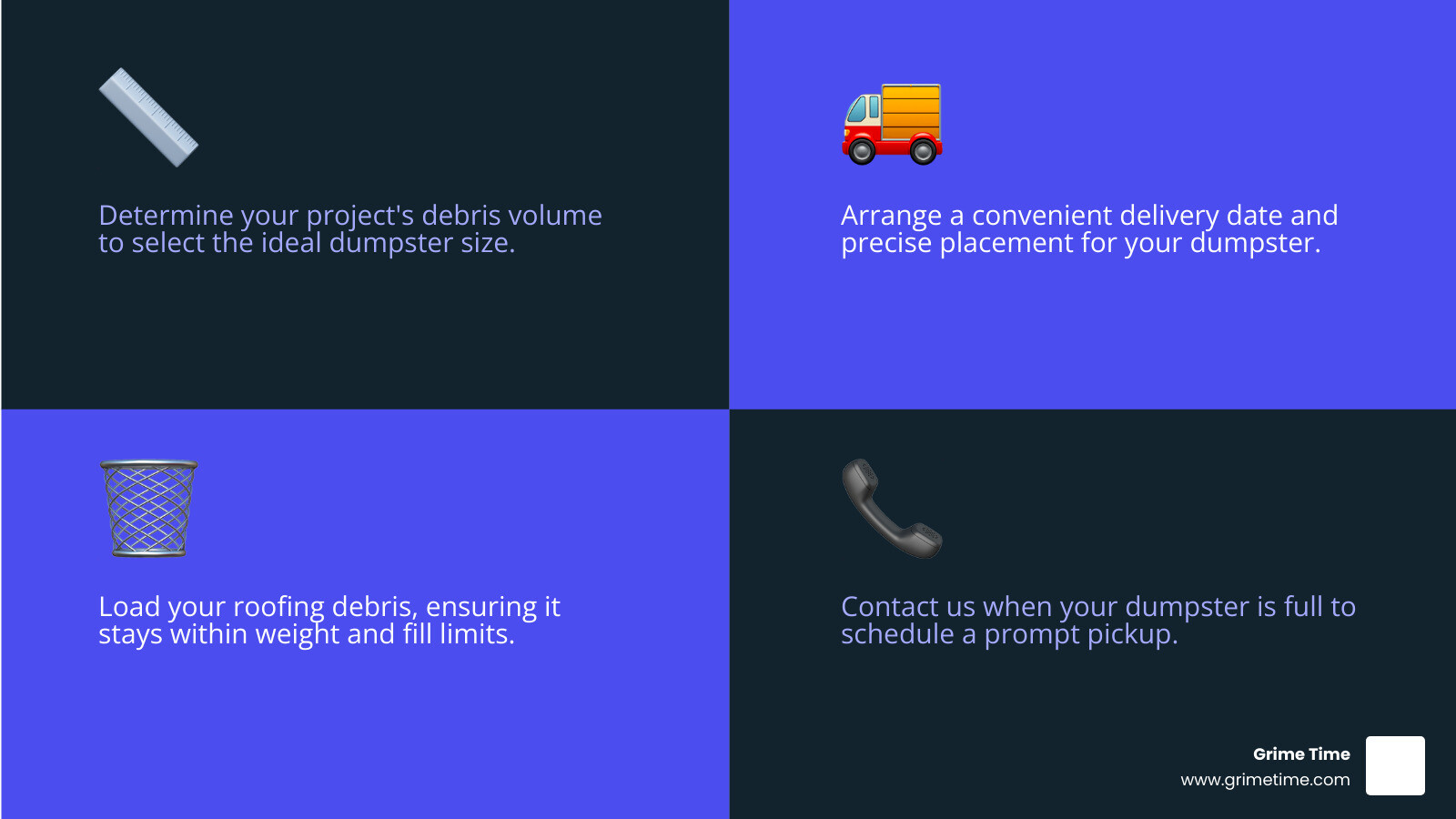
Dumpster for roofing terminology:
Estimating Your Debris: The First Step to a Perfect Dumpster Rental
Getting your dumpster for roofing project right starts with one crucial step: knowing exactly how much debris you’ll create. This isn’t about taking a wild guess and hoping for the best. It’s about understanding your roof’s size, what materials you’re dealing with, and how many layers are coming off.
Think of it like planning a dinner party – you wouldn’t order food without knowing how many people are coming, right? The same logic applies here. Skip the math, and you might end up with a dumpster that’s either too small (hello, extra fees!) or way too big (goodbye, hard-earned cash).
Our How to Rent a Dumpster guide walks you through our straightforward process, but first, let’s tackle the debris estimation that makes everything else fall into place.
How Different Roofing Materials Impact Weight
Here’s where things get interesting – not all roofing materials are created equal when it comes to weight. What looks like a manageable pile of debris can quickly turn your dumpster for roofing into an overweight nightmare if you’re not prepared.
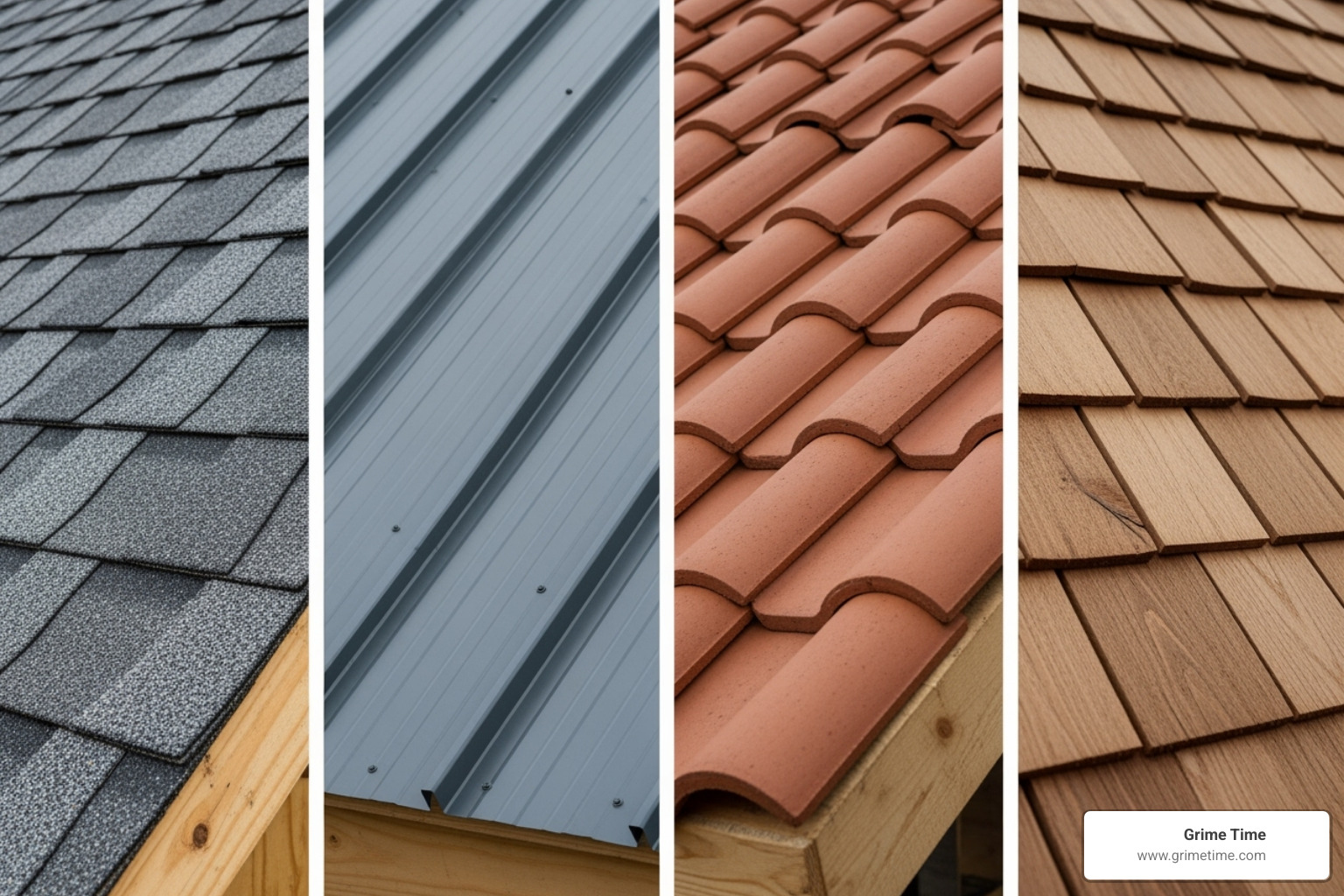
Asphalt shingles are the most common choice, but even they come in different weights. Three-tab shingles are the lighter option, typically creating about 2,400 pounds of waste per 1,000 square feet. That breaks down to roughly 240 pounds per roofing square (100 square feet).
Architectural shingles pack more punch – literally. These thicker, more durable shingles can generate up to 4,200 pounds of waste per 1,000 square feet. Per square, you’re looking at anywhere from 300 to 450 pounds for premium varieties.
If you’re dealing with slate or concrete tiles, buckle up. Slate can hit 9,500 pounds per 1,000 square feet, while concrete tiles can reach a whopping 11,500 pounds. Even a small roof with these materials can max out a dumpster’s weight limit fast.
Wood shakes might fool you – they’re bulky but generally lighter than asphalt. However, their volume can still fill up your container quickly, so don’t let their weight fool you into thinking you need less space.
These numbers are just for the roofing material itself. You’ll have plenty more debris to factor in, and Grime Time’s online resources can help estimate waste for your specific project.
Calculating Total Debris for Your Project
Now comes the fun part – turning your roof into numbers that actually make sense. Don’t worry, the math isn’t too scary.
Start by measuring your roof in squares. One roofing square equals 100 square feet, so a 2,000-square-foot roof equals 20 squares. Your roofing contractor should know this number, or you can measure it yourself if you’re feeling adventurous.
Next, multiply by your material weight. Using our earlier example, 20 squares of 3-tab asphalt shingles at 240 pounds per square gives you 4,800 pounds of shingle debris. But hold on – you’re not done yet.
Don’t forget the extras that add up fast. Underlayment like tar paper or synthetic barriers adds roughly 10 pounds per square. Nails and flashing might seem tiny, but thousands of nails plus all that metal flashing around vents, valleys, and edges contribute real weight. Tar and sealants from years of repairs also end up in your dumpster.
Here’s the big one many people miss: multiple layers. If your roof has two layers of shingles, you’ve just doubled your debris. That 20-square roof becomes 40 squares of waste – suddenly you’re looking at 9,600 pounds instead of 4,800.
Got some rotten decking or trim that needs replacing? That lumber goes in the dumpster too, adding even more weight and volume to your total.
This careful calculation is what separates a smooth project from a frustrating one filled with surprise fees and delays. Whether you’re tackling this yourself or working with a contractor, our Residential Dumpster Rental service takes the guesswork out of waste management, so you can focus on getting that roof done right.
Choosing the Right Size Dumpster for Roofing
Once you’ve calculated your debris weight and volume, selecting the perfect dumpster for roofing becomes much easier. The key is finding that sweet spot between weight capacity, physical space, and cost-effectiveness. At Grime Time, we’ve helped thousands of contractors and homeowners avoid the frustration of overage fees and project delays by getting the sizing right from the start. Check out our specialized Dumpster Rental for Roofing options to see how we make this process simple.
Here’s the thing about roofing debris – it’s deceptively heavy. Those shingles might not look like much when they’re on your roof, but once they start coming down, the weight adds up fast. Most dumpsters will hit their weight limit long before they’re physically full, which is why understanding tonnage limits is crucial for your project’s success.
Common Dumpster Sizes and Their Roofing Capacities
We offer several roll-off dumpster sizes, each designed to handle different scales of roofing projects. Let’s break down what works best for your specific needs:
10-yard dumpsters are perfect for smaller residential jobs. With a weight capacity of 2,000-4,000 pounds, they can typically handle up to 15 squares of 3-tab shingles or around 12 squares of heavier architectural shingles. If you’re re-roofing a shed, garage, or smaller home under 1,500 square feet, this size usually does the trick. You’ll typically spend between $300-$400 for this option.
20-yard dumpsters are our most popular choice for residential roofing projects. They can accommodate 4,000-6,000 pounds of debris, which translates to about 25 squares of 3-tab shingles or 20 squares of premium architectural shingles. For that standard 2,000 square foot home with a single layer of asphalt shingles, this size hits the sweet spot. Most homeowners find this option costs between $400-$500.
30-yard dumpsters step up to handle larger residential or light commercial projects. With a 6,000-8,000 pound capacity, they can manage 30+ squares of asphalt shingles. This size works well for larger homes over 3,500 square feet, roofs with multiple layers, or when you’re mixing roofing debris with other construction materials. Expect to invest $500-$600+ for this capacity.
40-yard dumpsters are the heavy hitters, designed for extensive commercial projects or residential jobs involving extremely heavy materials like slate or concrete tiles. With an 8,000-10,000 pound capacity, they’re essential when dealing with materials that can weigh 9,500-11,500 pounds per 1,000 square feet.
These weight limits aren’t suggestions – they’re hard limits that protect both you and our equipment. Going over means extra fees that can quickly exceed your original rental cost. Our team at Grime Time is always available to help you choose from our Dumpster Rental Sizes for Home Cleanouts in TX to our larger Roll-Off Dumpster Rental options.
Quick-Reference Sizing Guide
Making the right choice doesn’t have to be complicated. Here’s a straightforward guide that matches your roof size and material to the recommended dumpster for roofing size. This assumes a single layer of shingles – if you’re dealing with multiple layers, you’ll want to size up accordingly.
| Roof Size (Sq. Ft.) | Roofing Squares | Shingle Type (Single Layer) | Recommended Dumpster Size |
|---|---|---|---|
| Up to 1,500 | Up to 15 | 3-Tab Asphalt | 10-Yard |
| Up to 1,200 | Up to 12 | Architectural Asphalt | 10-Yard |
| 1,500 – 2,500 | 15 – 25 | 3-Tab Asphalt | 20-Yard |
| 1,200 – 2,000 | 12 – 20 | Architectural Asphalt | 20-Yard |
| 2,500 – 3,500 | 25 – 35 | 3-Tab Asphalt | 20-Yard (or 30-Yard for safety) |
| 2,000 – 3,000 | 20 – 30 | Architectural Asphalt | 30-Yard |
| 3,500+ | 35+ | Any Asphalt | 30-Yard or Multiple 20-Yards |
| Up to 1,000 | Up to 10 | Slate or Concrete Tile | 40-Yard (due to extreme weight) |
The golden rule? When in doubt, size up. It’s almost always more cost-effective to rent a slightly larger dumpster than to deal with overage fees or the hassle of scheduling a second pickup. Multiple layers of old roofing double or triple your debris volume, so factor that into your calculations.
At Grime Time, we’ve built our reputation on helping you get it right the first time. Our transparent pricing means no surprises, and our experienced team can walk you through the sizing process based on your specific project details.
Job Site Logistics: Placement, Safety, and Best Practices
A successful roofing project isn’t just about getting the right dumpster for roofing; it’s also about how you manage that dumpster on your job site. Proper placement, adherence to safety protocols, and smart loading techniques can save you from project delays, property damage, and unnecessary costs.
The Costs of Getting It Wrong
Underestimating or overestimating your dumpster size can have significant financial and logistical consequences.
- Underestimating the Size: This is the more common and often more expensive mistake. If your dumpster is too small or its weight limit is exceeded:
- Overage Fees: Dumpster rental companies typically charge $50-$250 per ton over the agreed-upon weight limit. These fees can quickly add up, sometimes costing more than the initial rental.
- Second Rental: If you fill your dumpster and still have debris, you’ll need to order a second one, incurring additional delivery, pickup, and rental fees. This leads to project delays and extra hassle.
- Project Delays: Waiting for an exchange or a new dumpster means your crew’s productivity drops, pushing back your project timeline.
- Safety Hazards: An overflowing dumpster can be unstable, making it dangerous for workers and potentially spilling debris onto the property.
- Overestimating the Size: While less problematic than underestimating, renting a dumpster that’s too large means you’re paying for unused space. Larger dumpsters naturally come with a higher base rental fee. While it’s sometimes wise to size up slightly for heavy materials, an excessively large dumpster for a small job is simply inefficient.
Our transparent billing at Grime Time aims to help you avoid these surprises. We believe in clear communication about weight limits and rental terms so you can manage your budget effectively. You can learn more about our pricing structure on our Dumpster Rental Pricing page.
Advantages Over DIY Hauling
Some contractors or homeowners might consider hauling roofing debris themselves using trailers. While this might seem like a cost-saving measure upfront, a dedicated dumpster for roofing offers numerous advantages that often make it the more efficient and professional choice.
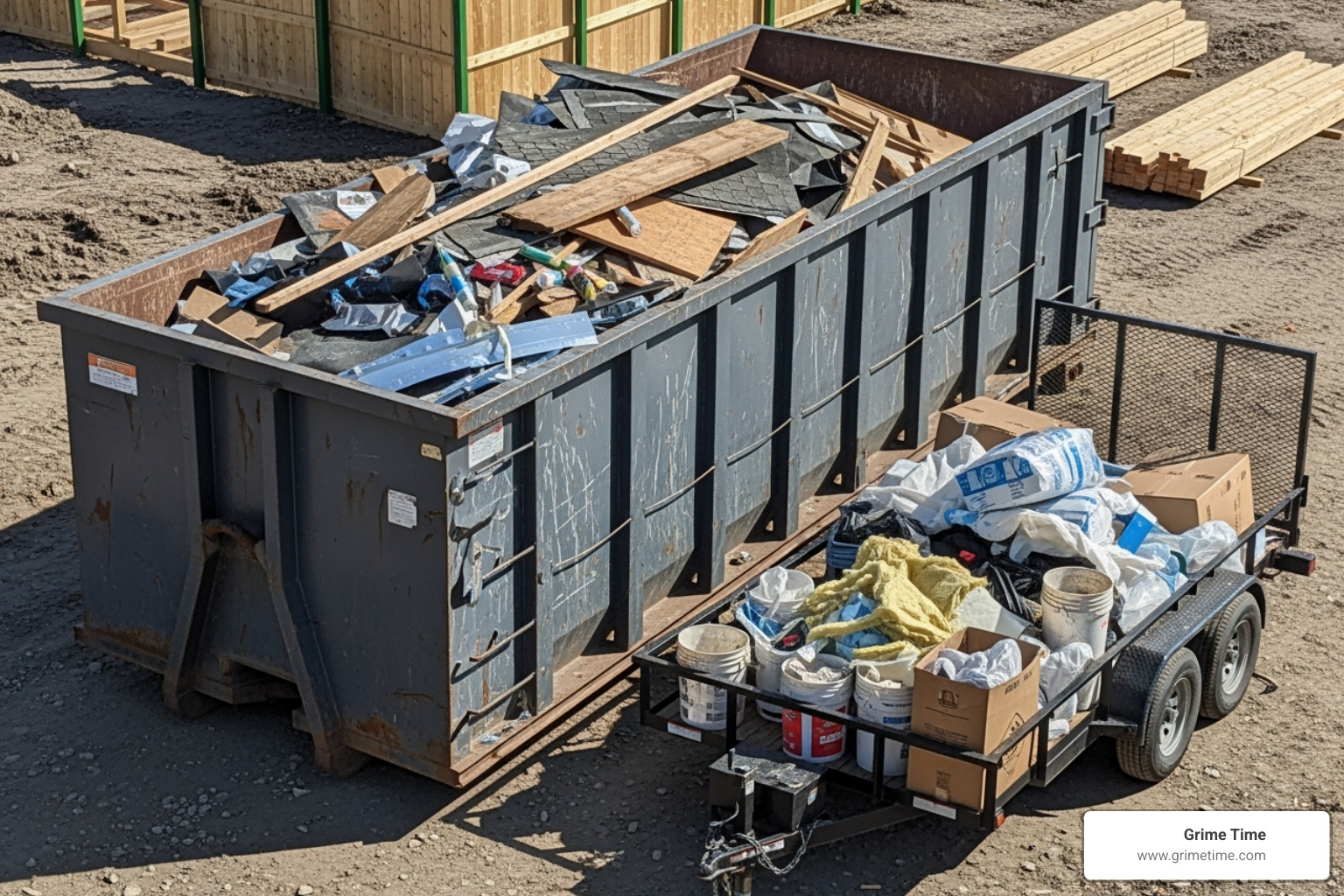
- Time Savings & Labor Reduction: Imagine making multiple trips to the landfill with a small trailer. Each trip involves loading, driving, unloading, and returning. A 20-yard roll-off bin rental can save you 4+ trips compared to a standard 5-yard trailer. This translates to significant labor hours saved, allowing your crew to focus on the actual roofing work. For three men, the labor cost for trailer hauling can easily exceed the cost of a dumpster rental.
- Fuel Costs: Multiple trips mean burning a lot of fuel, which adds up quickly, especially with rising gas prices.
- Safety Benefits: Roofing debris, particularly shingles with nails, poses a significant hazard. A dedicated dumpster keeps all this sharp, heavy material contained. Scattered nails can lead to tire punctures, injuries to workers or homeowners, and an overall messy, unsafe job site. The Occupational Safety and Health Administration (OSHA) notes that over half of roofing fall accidents involve falls of less than 15 feet, highlighting the importance of a clear and safe work area. Having a dumpster positioned close to the work area minimizes the distance debris needs to be carried, reducing fall risks. Read more about roofing fall statistics.
- Professionalism: A clean and organized job site reflects positively on contractors. A Grime Time dumpster shows clients you’re serious about safety, efficiency, and cleanliness. It avoids the impression of a makeshift operation and protects their property from scattered debris.
- Convenience: Our roll-off dumpsters are designed for easy loading, often featuring a swinging gate. We deliver the dumpster to your preferred location and pick it up when you’re done, eliminating the need for you to worry about transportation or landfill logistics. This contact-free delivery and on-demand scheduling ensures your project timeline stays on track.
For projects in Austin, Buda, Bastrop, Cedar Creek, Cedar Park, Coupland, Dale, Driftwood, Elgin, Georgetown, Hutto, Kyle, Lago Vista, Liberty Hill, Lakeway, Round Rock, San Marcos, Pflugerville, or Manor, we provide reliable and professional dumpster services that streamline your waste management, making your roofing project as smooth as possible.
Frequently Asked Questions about Roofing Waste Disposal
We get it – renting your first dumpster for roofing can feel overwhelming. You’re juggling project timelines, budgets, and trying to figure out what size won’t leave you scrambling for a second container or paying hefty overage fees. Let’s clear up the most common questions we hear at Grime Time so you can focus on what you do best.
What size dumpster for roofing do I really need?
Here’s the thing that catches most people off guard: it’s not about how much space your debris takes up visually. Roofing materials are sneaky heavy. That pile of shingles that looks like it should fit in a pickup truck? It probably weighs as much as a small car.
Weight beats volume every time. Your dumpster might look half-empty, but if it’s loaded with asphalt shingles, you could already be pushing the weight limit. This is why we always start with calculating pounds, not cubic yards.
Our rule of thumb keeps things simple. For smaller residential roofs under 1,500 square feet, a 10-yard dumpster typically handles the job. Most average homes with 1,500 to 3,500 square feet do great with a 20-yard container. Once you’re dealing with larger roofs or heavy materials like slate, you’re looking at 30-yard or even 40-yard dumpsters.
Multiple layers change everything. If you’re tearing off a roof that’s had shingles added over the years instead of replaced, double your weight estimate for each layer. That seemingly modest 2,000-square-foot roof becomes a 4,000-square-foot disposal job if it has two layers.
When you’re torn between two sizes, sizing up almost always saves money and headaches. The cost difference between a 10-yard and 20-yard dumpster is usually much less than overage fees or ordering a second container mid-project.
Can I mix other debris with shingles in my dumpster?
Absolutely! We understand that roofing projects create more than just shingle waste, and our dumpsters are designed to handle the reality of construction work.
Most roofing debris plays well together. Your Grime Time dumpster can handle asphalt shingles alongside underlayment, old lumber from decking repairs, metal flashing, nails, screws, and even dried tar or foam. Wood shakes, cedar shingles, and even heavy materials like slate or concrete tiles are all welcome – just remember those weight limits we talked about.
The no-go list is pretty straightforward. We can’t accept hazardous materials like paints, solvents, or chemicals. Tires, refrigerants, medical waste, electronics, and propane tanks need special handling. Food waste is also a no – but honestly, if you’re eating lunch on the roof, we’re impressed by your balance.
Asbestos deserves special mention. Modern shingles aren’t a problem, but if you’re working on a pre-1980s roof, there’s a chance of asbestos-containing materials. These require certified professionals and special disposal – they absolutely cannot go in a standard dumpster. When in doubt, ask us. We’d rather answer questions upfront than deal with regulatory headaches later.
The beauty of our service is that we don’t require “clean loading.” We know roofing tear-offs create mixed debris, and we’ve built our service around that reality.
How do I avoid extra fees when renting a dumpster for roofing?
Nobody likes surprise charges, and we pride ourselves on transparent pricing at Grime Time. The best way to avoid extra fees is understanding what causes them in the first place.
Weight management is your biggest money-saver. Take the time to calculate your debris weight accurately. Account for shingle type, roof size, and those sneaky multiple layers. When your crew knows the weight limit, they can load smartly and avoid costly overages.
Timing matters too. Our rental periods are designed to be generous, but if your project runs long, just give us a heads up. Planning extensions ahead of time costs less than scrambling at the last minute.
Keep it clean and accessible. Load prohibited materials into your regular trash, not our dumpster. Make sure our drivers can easily reach your dumpster for delivery and pickup – blocked access can lead to trip fees that nobody wants to pay.
Level loading isn’t just about fees – it’s about safety. Distribute weight evenly so our drivers can transport your dumpster safely. An unbalanced load might need redistribution before pickup, causing delays.
At Grime Time, we believe in no hidden fees and clear communication. We’ll walk you through all potential costs upfront, so your budget stays on track and your dumpster for roofing rental is as straightforward as your project deserves.
Conclusion: Streamline Your Next Project with the Right Partner
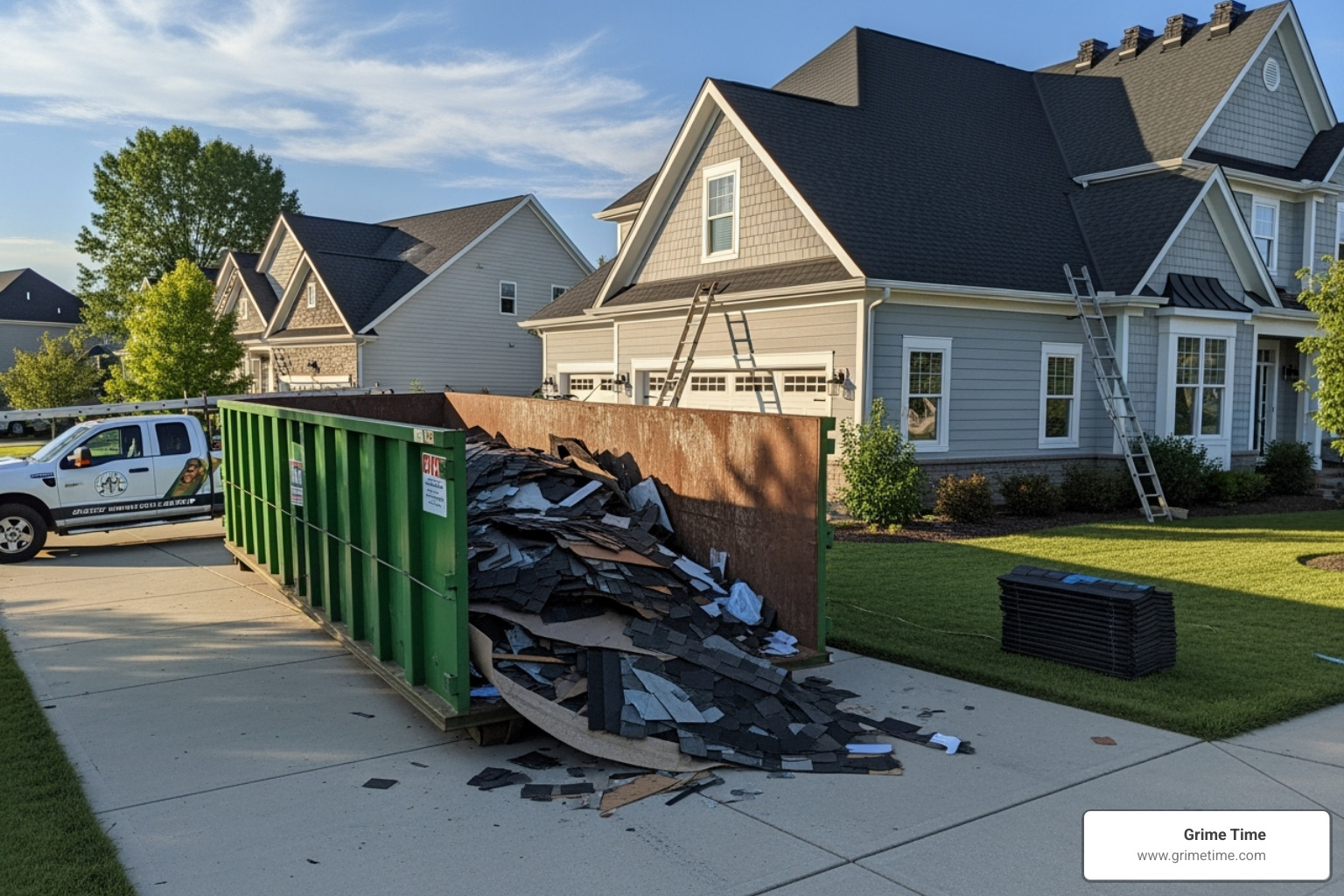
Getting your roofing project right comes down to smart planning and choosing the right partners. When you understand how material weight affects your dumpster choice, account for those sneaky multiple layers, and plan for proper placement, your project transforms from a potential headache into a smooth operation.
We’ve seen too many contractors get burned by underestimating their debris or choosing the wrong size dumpster. The math matters – but it doesn’t have to be complicated when you have the right guidance. Whether you’re dealing with lightweight 3-tab shingles or those hefty architectural varieties, knowing your numbers upfront saves you from those painful overage fees down the road.
At Grime Time, we believe waste management should be the easiest part of your roofing project, not another stress point. That’s why we focus on transparent pricing – no surprise fees lurking in the fine print. When we quote you a price for your dumpster for roofing, that’s what you’ll pay. Simple as that.
Our contractor programs recognize that professional roofers need reliable partners who understand tight schedules and demanding clients. Priority service means your dumpster arrives when promised, and our contractor discounts help keep your project margins healthy. We get it – when you’re managing multiple job sites, the last thing you need is a waste management company that doesn’t deliver on their promises.
From the rolling hills around Dumpster Rental Austin to the growing communities in Dumpster Rental Round Rock, we’ve been helping Central Texas tackle roofing projects of every size. Our local knowledge means we understand everything from permit requirements to the best placement strategies for your specific area.
Whether you’re working in Buda, Bastrop, Cedar Creek, Cedar Park, Georgetown, Hutto, Kyle, or any of our other service communities, we bring the same commitment to efficient waste disposal and project success. We’ve handled everything from small residential tear-offs to major commercial re-roofing projects, and we’re ready to make your next job just as smooth.
Ready to experience the difference that reliable, transparent service makes? Don’t let debris disposal become an afterthought that derails your timeline or budget. Contact us for your project in Dripping Springs or anywhere across Central Texas, and let’s get your dumpster for roofing scheduled today. Your future self will thank you for making the smart choice upfront.

